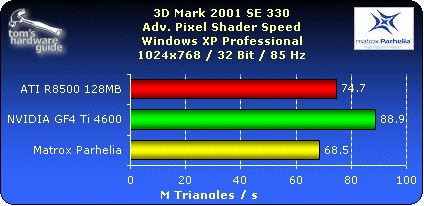Attack Out Of The Blind Spot: Matrox Parhelia-512
Pixel Shader Speed
In this special test, 3D Mark measures the performance of the pixel shaders. In the standard test, pixel shaders based on version 1.3 are used. The Advanced Pixel Shader Text, however, tests version 1.4, which was introduced by ATI. Therefore, ATI cards should be faster than GF4 Ti and Parhelia in this test.
- Pixel Shader
Pixel shader is a technique for making custom per pixel lighting and other per pixel operations in a 3D scene. Bump mapping is a kind of per pixel operation, because it makes a surface look bumpy due to modifications of the pixel colors, without touching the scene geometry, or, in other words, the polygons of the scene. This test demonstrates a water surface drawn with a pixel shader doing environment bump mapping using a cube map. This test requires DirectX 8 compatible hardware with Pixel Shader 1.0 support. The graphics card needs to be capable of four texture layers in a single pass to produce this water surface in a single pass. - Advanced Pixel Shader
This is a new test included in 3DMark2001 SE, and it uses Pixel Shader version 1.4, introduced in DirectX 8.1. The same effect can also be achieved using Pixel Shader 1.0, but then rendering the water surface requires two passes. Graphics hardware that supports Pixel Shader 1.4 (or higher) renders the water in a single pass. The water surface in this test is more realistic than in the test above. Instead of just an environment bump map reflecting a cube map, this test uses a ripple texture (traditional environment bump map), a reflection texture, a refraction texture and a Fresnel texture. The resulting effect is a water surface that has ripples from the wind, for example, shows a rippled reflection and a rippled refraction (view of objects beneath the water surface), while also adjusting the reflection intensity according to the camera's angle to the water surface. For example viewing the water's surface from a perpendicular angle will show only refracted light rays, or what's under the water surface, while looking almost parallel to the water's surface will show the reflection only.
Again, the Parhelia clearly lags behind the GeForce 4, which is doubly fast in the simple pixel shader test. Nor can the Parhelia catch up with the performance of the R8500. The surprising part is that the Parhelia is faster in the Advanced Pixel Shader Tests than in the standard tests, because this means more effort in calculation for cards with pixel shaders v1.3.
Get Tom's Hardware's best news and in-depth reviews, straight to your inbox.

